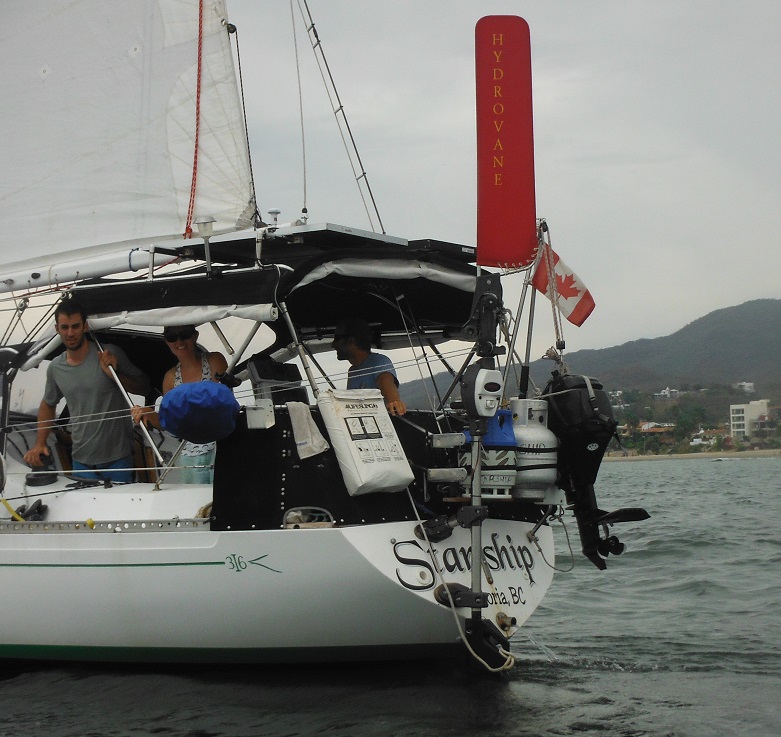 Islander 36
Islander 36
A report from Day 10 of the Pacific Puddle Jump
One of a few reasons for choosing Hydrovane: “The wheel is stationary! With the electric autopilot (and some other windvanes), the main wheel spins as the course is adjusted. This makes the wheel a dangerous thing to be around. It is so nice to have the wheel locked down, and not to worry about it when relaxing in the cockpit.”
From Chris & Anne-Marie’s Blog – SV Starship
WEDNESDAY, APRIL 3, 2013
1000 Nautical Miles Down! – Day 10
1000nm down, about 1800nm to go!
Hard to believe it has been 10 days already! I think we have been doing quite well progress wise, especially with our slow 3-4 days getting off the coast, to pull off a little over 100nm per day. Hopefully now that we are in the trade winds we will be able to routinely knock out 125+nm days. Alas it looks like I have lost the bet with my guess of us completing the crossing in 21 days.
One piece of equipment we have been exceptionally happy about has been our Hydrovane (www.hydrovane.com)! There is no doubt it would be a totally different experience out here had we been relying solely on our electronic autopilot as initially planned. To the best of my knowledge no one has hand steered since we shut off the engine just outside of Banderas Bay. The Hydrovane has been doing all the tough work of keeping us on course, while we enjoy the scenery and tend to other tasks onboard.
Here is a brief rundown of why we like the Hydrovane so much:
What sold us on it:
- Could be installed off center, since our transom had a lot of stuff already on it
- Only 4 bolts to install the unit on the transom
- Emergency totally independent rudder
- No power drain when compared to using the electric autopilot
From our experience with it:
- Works as advertised (or better)! We used the Hydrovane running down wind in 35kt winds crossing to Banderas Bay from the East Cape of Baja, and it only seemed to work better the windier it got! On this crossing we were using it to keep us heading in the right direction with only 2kt of apparent wind!
- No steering lines enter the cockpit as on some other windvane self steering systems. The Hydrovane is totally independent on the transom of the boat. No connections to the main wheel or rudder post. Simple, clutter free and redundancy.
- Quiet! It just does it thing back there and you’d never even know it was there until you look. In comparison with our electric autopilot which is always making noise as it alters the course….sqeekkk…sqeeekkkk..sqeekk… I’m sure we would have went insane by now listening to that!
- The wheel is stationary! With the electric autopilot (and some other windvanes), the main wheel spins as the course is adjusted. This makes the wheel a dangerous thing to be around. It is so nice to have the wheel locked down, and not to worry about it when relaxing in the cockpit.
- Huge power savings! There is no power draw whatsoever with the Hydrovane. Compared to possibly as high as 50Ah/day with our electric autopilot. This has allowed us to keep fully charged under solar power alone for our first 10 days. That is with running computers, the fridge, checking emails/weather 2x a day, and Anne-Marie being net controller for the puddle jump fleet (30-45 minutes of talking on the SSB radio, ~12Ah of battery).
If you are in the market for a windvane, give the Hydrovane a good look. Somehow I didn’t consider them when looking at windvanes before leaving the US, and only after meeting Will & Sarah of Hydroquest, who work for Hydrovane did we consider it an option. Will was super helpful in checking out all the stuff on our transom to ensure the Hydrovane would work, which made it a lot easier for us to make the decision.
Full Disclosure: Although we are friends with Will & Sarah, we are not associated with the Hydrovane company and they have no idea I’m writing this post.
[Editor’s note: It’s true! We had no idea Starship was writing such a great testimonial… we were in the middle of the Pacific, ‘puddle jumping’ at the same time!]
Contact
